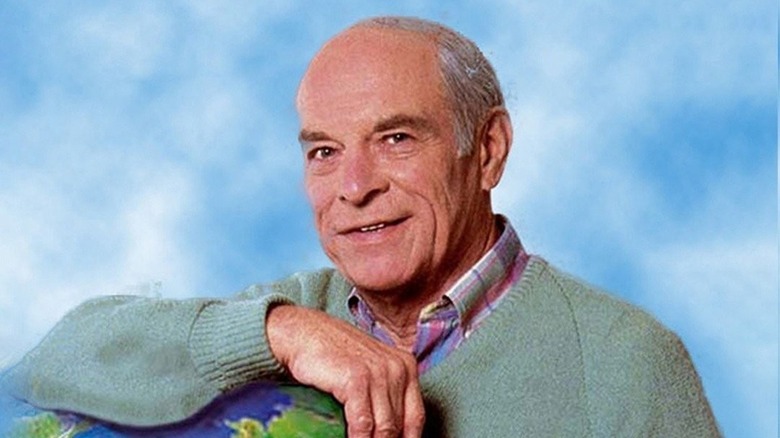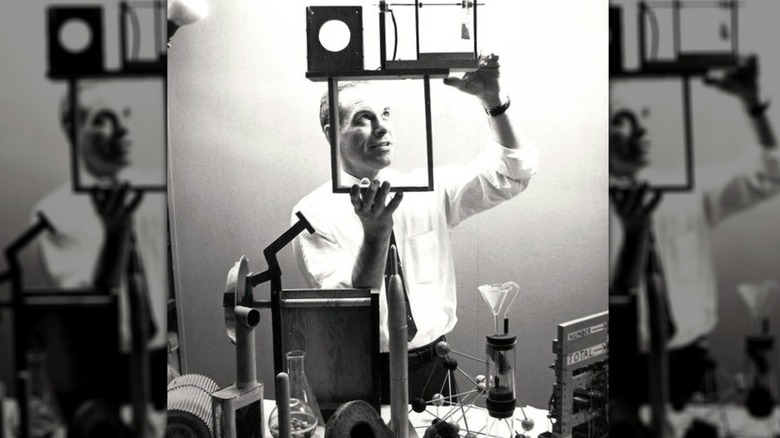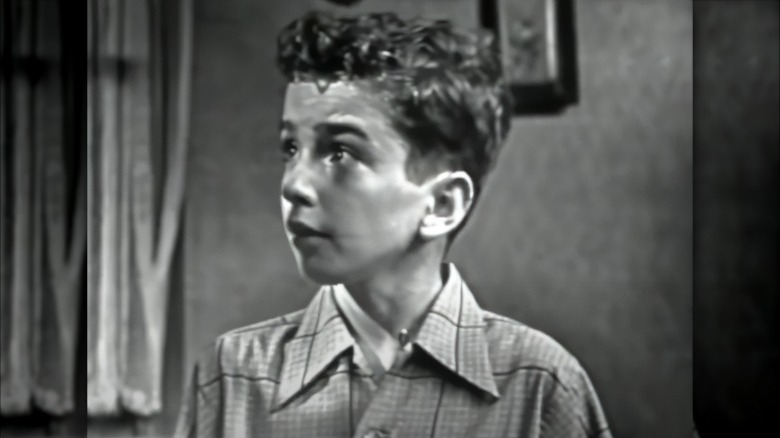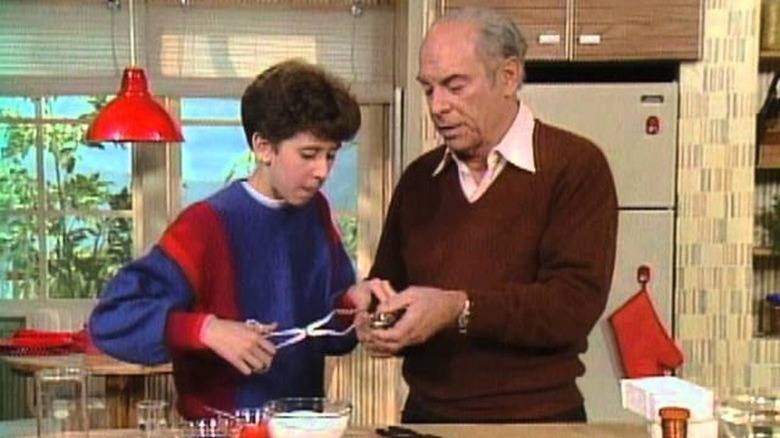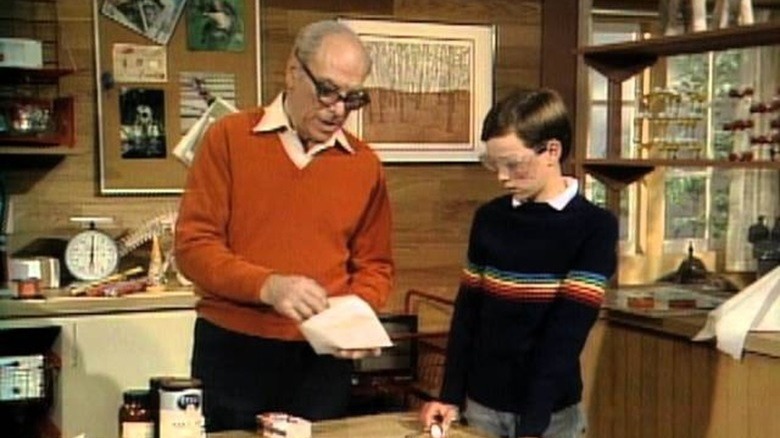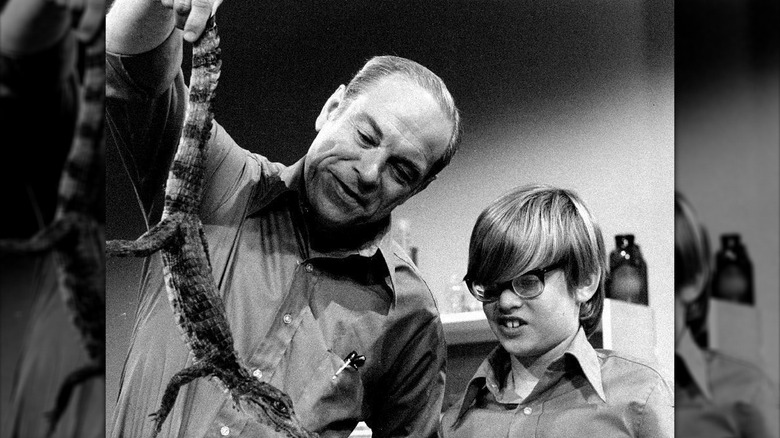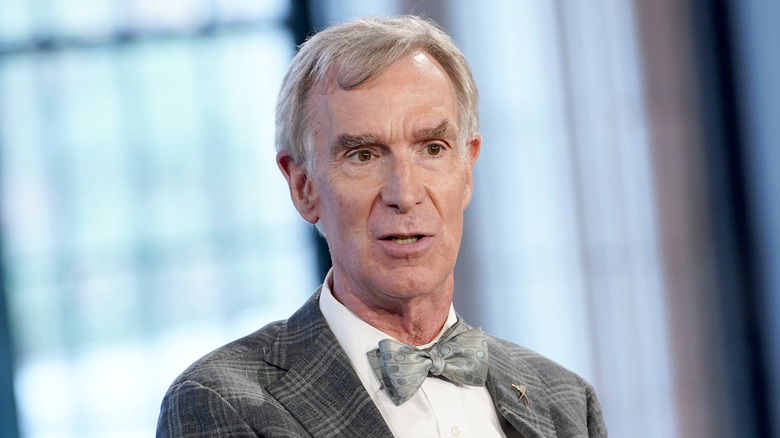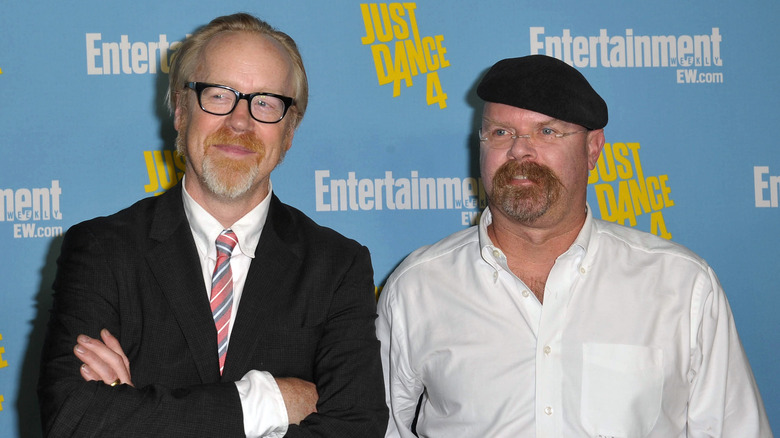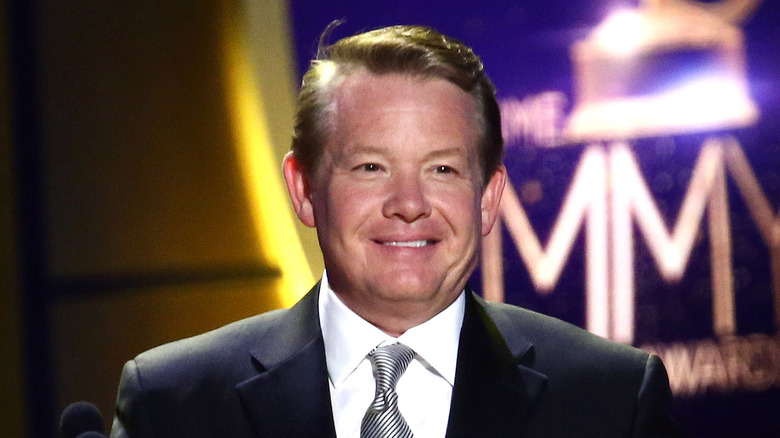The Untold Truth Of Mr. Wizard
Simplifying science is an art form that Don Herbert, aka Mr. Wizard, perfected. The presenter arrived at a time when educational television didn't excite young viewers with its formulaic and heavy-handed approach, but Herbert turned this model on its head with the release of "Watch Mr. Wizard," which aired from 1951 to 1972. The show demystified science, as Herbert and his young assistants would utilize regular, everyday household items to conduct dazzling scientific experiments. More importantly, Mr. Wizard achieved his main objectives: to educate and entertain children.
After "Watch Mr. Wizard" concluded its run, Herbert continued to use his persona to encourage kids to learn more about science. In 1983, an updated version of his famous show returned to television in the form of "Mr. Wizard's World," airing until 1989. Utilizing a similar approach from before, but with a modernized sensibility, Herbert inspired the next generation of science lovers, while also bringing himself a newfound level of celebrity as everyone's favorite television teacher.
As Mr. Wizard, Herbert not only had a hand in helping push young people's interest in science, but he also revolutionized educational television, proving it can be both informative and entertaining. Simply put, without "Watch Mr. Wizard" and "Mr. Wizard's World," there would be no "Bill Nye the Science Guy" or "MythBusters." With that said, let's find out more about these seminal science shows and the man behind them.
Don Herbert created Mr. Wizard
In the 1950s, educational television struggled to hook its primary target audience: children. Science-related shows dug too deep into the weeds or overly relied on comedy to get their points across to the viewer. The problem? These series were designed to appeal to the parents more than the kids. It was nothing out of the ordinary and still remains one of the oldest tricks in television and marketing: Sell the concept to the adults in order to reach the children. While educational programming found its way into homes in this era, none of the shows turned into the smash-hit sensation that "Watch Mr. Wizard" would become. This is because Don Herbert decided to flip the script on the whole model.
While working as an actor on children's radio shows in the late 1940s, he conceptualized the idea of Mr. Wizard as an entertainer and teacher. Herbert wanted to create a show that didn't speak down to the children or overcomplicate science. Instead, he envisioned Mr. Wizard to talk directly to the kids and involve them in what he did. Herbert pitched the premise, and WNBQ agreed to run "Watch Mr. Wizard."
The format of the program also ensured that it wouldn't be a massive financial risk for the network. Since Mr. Wizard used regular household items and didn't have an overelaborate set, the budget paled in comparison to other more expensive shows of the time.
Mr. Wizard also learned about science while filming his show
Whether it be on "Watch Mr. Wizard" or "Mr. Wizard's World," Don Herbert displayed a confidence and comfort in explaining the experiments and unpacking complex scientific terms to his young cohorts and the audience. In fact, anyone watching would be led to believe Herbert held an advanced degree or doctorate in the field. He didn't.
Speaking to The New York Times in 2004, Herbert revealed his science background wasn't as in-depth as many people might have imagined. "I have a general degree in science, but everything on the show I learned while I was doing it," he said. "I had some of the vocabulary from college, but everything was pretty much from scratch. I did quite a bit of research for the show; I have 18 file cabinets full of notes."
Herbert graduated from the La Crosse State Teachers College of Wisconsin, now known as the University of Wisconsin-La Crosse, with a degree in both English and general science in 1940. However, his main interest remained in show business, specifically acting. After serving in World War II, he pursued his entertainment industry dreams in Chicago, which eventually led to the creation of "Watch Mr. Wizard."
Watch Mr. Wizard's first sidekick went on to have a career in television
While Don Herbert was undoubtedly the star of "Watch Mr. Wizard" and "Mr. Wizard's World," his youthful sidekicks brought authenticity and realism to the shows as they conducted the experiments and learned from him. They represented the audience watching at home and proved if they could do it, then anyone else could as well. In the early stages of "Watch Mr. Wizard," Mr. Wizard was joined by his 11-year-old neighbor, Willy Watson, who appeared as his assistant on a number of episodes.
Herbert would show Willy how the experiments would work, then have the child ask questions and recreate them. Eventually, a decision was made to change up the format of the program and have different children appearing on the show, instead of just one.
Willy was played by actor Bruce Lindgren, whose stint in "Watch Mr. Wizard" helped him catch the television bug and led to a lengthy career in the industry. Lindgren would hold a position as a promotions director for a San Francisco television station, while also running his own network television consulting business at one point. In 2021, Lindgren died from complications related to congenital heart failure. He was 81 years old.
Mr. Wizard's World pushed a lot of younger people into the science field
In 1961, Don Herbert told the St. Louis Post-Dispatch that he didn't believe Mr. Wizard had a direct impact on children's lives or encouraged them to become scientists, saying there were other factors that would influence this kind of decision. Through this statement, Herbert may have inadvertently challenged the universe to prove him wrong, as he built up a formidable fan base across different generations of viewers. There were 1,000s of Mr. Wizard Science Clubs around the U.S., while numerous children cited him for piquing their initial interest in science.
After the release of "Mr. Wizard's World" in the '80s, he received special recognition from the National Science Foundation. Official George Tressel took the time to single out Herbert for his contribution to the field in 1989, stating (via The Seattle Times), "Over the years, Don has been personally responsible for more people going into the sciences than any other single person in this country. I fully realize the number is virtually endless when I talk to scientists. They all say that Mr. Wizard taught them to think."
Notes were hidden around the sets for reference
A major part of the magic of "Watch Mr. Wizard" was the fact it was recorded live. Expectedly, this didn't leave a lot of room for error, as everything happened in real time, and there was a lot of information to be remembered for a 30-minute program. While viewers might have thought that Don Herbert had an incredible wealth of scientific knowledge stored in his brain, or was simply excellent at memorizing his lines, Herbert revealed there were two secrets to pulling it off, in a setting that didn't allow for clever edits or reshoots to cover up for mistakes.
Speaking to The New York Times, Herbert explained how he and the children would rehearse twice before filming, so that they would have familiarity with the material beforehand. However, he also had another important trick up his sleeve — or more specifically, around the set — when the audience was distracted. "I had notes hidden all over the set," he said. "If I was off camera for a second, I would sneak a [peek] at them."
Why the shows didn't feature fancy scientific tools or instruments
From Bunsen burners to microscopes and flasks, scientists have a multitude of tools and instruments to conduct their experiments at their disposal. However, this wasn't what Mr. Wizard was about or wanted to promote on his shows, as revealed by a former "Mr. Wizard's World" assistant.
Steve Jacobs spoke to CBS News about the experience of working with Don Herbert behind the scenes on "Mr. Wizard's World," and why the popular host rejected using traditional science equipment on the program. Jacobs said: "He tried to bust the image of scientists and that science wasn't just for special people and places."
Jacobs explained how Herbert chose to use regular household items that children would also have access to, instead of the traditional items found in a lab setting. This also helped to eliminate any barriers of entry for the kids wanting to conduct the experiments, since they wouldn't need to purchase special instruments or accessories but could make use of what was freely available in their own garages or kitchen cupboards.
Mr. Wizard's World was a big show for Nickelodeon
Nowadays, Nickelodeon is a juggernaut, owned by Paramount Global and holding the rights to air popular programming such as "SpongeBob SquarePants" and "The Loud House." However, in the early days, the television channel wasn't a runaway success that steamrolled everything in its path. It took time for Nickelodeon to build its reputation and establish itself as a prime destination for children's programming. The addition of "Mr. Wizard's World" in 1983 proved to be an essential part of the early lineup and helped the channel grow its appeal among the young audience, while also having a built-in celebrity in the form of Don Herbert.
As a modernized version of "Watch Mr. Wizard," this updated show moved faster and featured more segments than its predecessor. At the same time, Nickelodeon decided to air "Mr. Wizard's World" three times a week — partially because it also needed enough programming to fill the available time slots. While the show didn't receive the lengthy run or number of episodes which "Watch Mr. Wizard" had several decades earlier, it ran for five seasons, which is like a lifetime by current television standards.
Although new episodes ceased to be produced by the late '80s, "Mr. Wizard's World" didn't disappear from Nickelodeon entirely, as the reruns continued to air until the year 2000.
Mr. Wizard's World featured more diversity
Modern television remains progressive, largely shunning away from sexist stereotypes and supposed gender roles. However, this wasn't the case in the past, as older programs carried certain stigmas and prejudice in what roles and fields of studies should be done by which gender. Science, for example, was seen as exclusively for men. At the time of its airing in the 1950s, "Watch Mr. Wizard" proved to be unique as it showcased both boys and girls learning about science, and receiving equal opportunity to participate on the show. Don Herbert also did his bit by flipping the expectations and placing boys in the kitchen and girls in the garage. Undoubtedly, this was a major step forward in terms of challenging stereotypes on a national platform.
When "Mr. Wizard's World" debuted in 1983, Herbert continued to promote inclusivity and diversity in the co-hosts featured. Not only was there a good balance between the boys and girls on the show, but he also encouraged more racial and ethnic diversity among the kids. This had been absent in "Watch Mr. Wizard" — and, quite frankly, most shows of the era — but Herbert ensured that children of all races, ethnicities, and genders received the chance to learn about science.
Mr. Wizard turned Don Herbert into a TV celebrity
Thanks to the lengthy "Watch Mr. Wizard" run and his subsequent appearances in other science-related programming, Don Herbert established himself as a recognizable figure among the American public. However, this didn't confine him to only educational programming. Herbert's friendly personality and game-changing endeavors caught the eye of the larger entertainment industry and saw him pop up on the game show "Hollywood Squares," as well as appear as a guest of Johnny Carson and Regis Philbin on their respective talk shows.
However, Herbert's most notable appearance arrived on February 1, 1982. It was the night in which "Late Night with David Letterman" premiered on television and Mr. Wizard served as one of the host's first guests. David Letterman invited Herbert to be on the show, since he grew up watching "Watch Mr. Wizard," and the beloved science teacher didn't disappoint those in attendance and the people watching at home. He conducted one of his experiments and had Letterman serve the role of his assistant, while also taking the time to explain to everyone how it was done. In 1983, Herbert was back on television in a regular capacity with "Mr. Wizard's World."
Bill Nye was influenced by Watch Mr. Wizard
Modern audiences know Bill Nye as the energetic, bowtie-wearing science teacher on television. He has utilized his natural charisma and quirky experiments to land himself numerous high-profile shows, and even cross over the pop-culture stratosphere, appearing in series such as "The Big Bang Theory" and "Dancing with the Stars." That said, it doesn't take a rocket scientist to see Nye's road to success was paved by the bricks that Don Herbert laid as Mr. Wizard.
After Herbert's passing at the age of 89 in 2007, Nye penned a heartfelt tribute piece to him in the Los Angeles Times. Nye mentioned the influence that "Watch Mr. Wizard" had on countless people, including himself, before expressing how he modeled himself on Mr. Wizard and his approach to educational television.
"As an informal (non-classroom) educator, I grew up loving Mr. Wizard and then later studying his moves," Nye wrote. "If any of you reading now have been surprised and happy to learn a few things about science watching 'Bill Nye the Science Guy,' keep in mind, it all started with Don Herbert."
MythBusters learned from Mr. Wizard
For over 20 years, the "MythBusters" franchise has established itself as a cornerstone of the reality television world. The premise is simple: A team analyzes popular rumors, myths, or Internet stories and tests their validity through scientific methods. Either they dispel or prove it right, leaving the audience knowing what's fact and what's false. While it isn't exactly the same approach that "Watch Mr. Wizard" or "Mr. Wizard's World" used, the "MythBusters" team has credited Don Herbert for sparking their interest in science. Adam Savage admitted to watching and admiring Mr. Wizard while growing up; however, he cited the major difference between what Herbert did and "MythBusters" does.
"Mr. Wizard knew what he was talking about," Savage told The Columbus Dispatch. "He was a scientist. We know a little [science] from doing this show for so long. But, basically, we are learning the science at the same time as the viewer." After Herbert passed away, "MythBusters" dedicated a special two-hour episode to his memory and legacy.
Steve Spangler revealed Mr. Wizard's secret for success
Steve Spangler is another media personality who counts Mr. Wizard as a major influence on his life and career. Writing on his blog, the television host and author admitted he grew up watching Don Herbert's experiments and finding himself mesmerized by what he witnessed. Inevitably, this led to Spangler becoming the science host for the television show "News for Kids" in the early '90s.
Spangler revealed how when he was approached for the position by NBC, he decided to seek counsel from Herbert and get his input on how he should approach the gig. According to Spangler, Herbert told him the following: "Don't let them put you in a lab coat if you don't want to look like a doctor or research scientist ... just be yourself ... and ... never let the 'gee-whiz-factor' overtake what you are trying to teach."
For Spangler, he cherished the advice as he understood this is exactly how Herbert approached his own shows. The key was to make science accessible to everyone and not to try to mask what one was doing with too many bells and whistles. The secret behind Mr. Wizard's "wizardry" was always simplicity.
